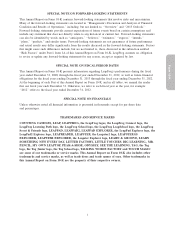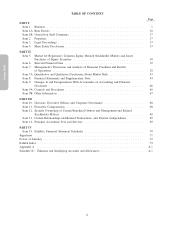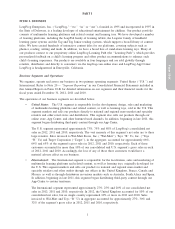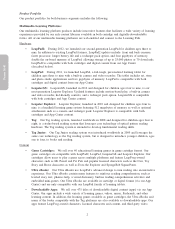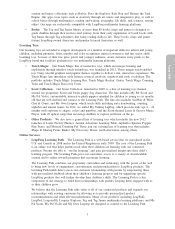LeapFrog 2012 Annual Report Download - page 15
Download and view the complete annual report
Please find page 15 of the 2012 LeapFrog annual report below. You can navigate through the pages in the report by either clicking on the pages listed below, or by using the keyword search tool below to find specific information within the annual report.
granted is adequate relative to the expected lives of our products. While our patents are an important element
of the protection of our intellectual property, our business as a whole is not materially dependent on any
one patent.
For a discussion of how our intellectual property rights may not be sufficient to prevent other companies from
using similar or identical technology, see Part I, Item 1A. — Risk Factors — ‘‘If we are unable to maintain or
acquire licenses to include intellectual property owned by others in our games, our operating results will
suffer.’’ For a discussion of how our intellectual property rights may not insulate us from claims of
infringement by third parties, see Part I, Item 1A. — Risk Factors — ‘‘Third parties have claimed, and may
claim in the future, that we are infringing their intellectual property rights, and we may not succeed in
protecting or enforcing our intellectual property rights.’’
In addition to proprietary materials we have developed, we use various licensed technologies in some of our
key products, such as LeapPad, Leapster and Tag. Our continued use of these rights is dependent on our
continued compliance with applicable license terms. Any failure to do so could interrupt our supply chain and
require us to modify our products or business plans. Please see Part I, Item 1A. — Risk Factors — ‘‘If we are
unable to maintain or acquire licenses to include intellectual property owned by others in our games, our
operating results will suffer’’ for further discussion of the risks we face in relying on third-party technology
licenses for our products.
Seasonality
Our business is highly seasonal with a significant portion of our revenue occurring in the second half of the
year. Given relatively low sales volumes in the first half of the year and the fixed nature of many of our
operating expenses, which occur fairly evenly throughout the year, our results of operations have historically
been stronger in our third and fourth quarters relative to our first and second quarters. Conversely, our cash
flow from operations tends to be highest in the first quarter of the year when we collect a majority of our
accounts receivable related to sales made in the fourth quarter of the prior year. Cash flow from operations is
generally lowest in our third quarter, as accounts receivable collections taper off and we build our inventory
levels in preparation for the fourth quarter holiday season. The reduction in cash flow in the third quarter
generally means that our available cash is at its lowest point for the year in the first month of the
fourth quarter.
Our seasonal sales patterns for the years ended December 31, 2012, 2011 and 2010 are shown in the
table below.
Years Ended December 31,
2012 2011 2010
Percent of total net sales:
1
st
quarter ...................................... 13% 9% 10%
2
nd
quarter ..................................... 12% 12% 14%
3
rd
quarter ..................................... 33% 33% 32%
4
th
quarter ..................................... 42% 46% 44%
Total ......................................... 100% 100% 100%
Seasonal purchasing patterns and their related production lead times create risk in our business due to possible
under-production of popular items and over-production of items that do not match consumer demand. In
addition, our retail customers continue to manage their inventories stringently, requiring us to ship products
close to the time of expected consumer demand. For more information about the effects of seasonality on our
business see Part I, Item 1A. — Risk Factors — ‘‘Our business is highly seasonal, and our annual operating
results depend, in large part, on sales relating to the brief holiday season.’’
Financial Information about Geographic Areas
Financial information regarding export sales and international operations versus U.S. sales and operations is
included in Note 20 — ‘‘Segment Reporting’’ in our Consolidated Financial Statements included in this
Annual Report on Form 10-K. For information regarding risks associated with our foreign operations upon
7




